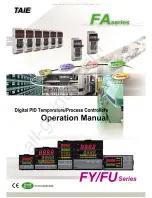
Parker Hannifin
other words, each I/O bit is controlled by only one flag. In addition,
this table represents the maximum amounts of I/O that can appear
at XIO flag parameters 4104-4111. For example, if P32771= 1 and
Node 0 only has 32 physical inputs and outputs, only flag parameters
4104 and 4105 have meaning.
Semi-Automatic Network Configuration
The network configuration is as automatic as possible, but the user
must adjust some settings. The ACR9000 controller automatically sets
other configuration parameters required for CANopen, including the
global analog data enable (For more information, see the Parker I/O
manual). The table below gives the parameters the user must set,
along with their default values. The default values apply on power
up if user supplied values have not been saved with the
ESAVE
command. Each parameter is described in further detail in
subsequent paragraphs.
Parameter
P number
Default value
Master Node Id
P32768
5
Bit Rate (kilobits/second)
P32769
125
Number of slave nodes
P32770
1 (valid range
0-4)
Cyclic Period (milliseconds)
P32772
50
Node 0 ID (required if
P32770 > 0)
P33024 1
Node 1 ID (required if
P32770 > 1)
P33040 0
Node 2 ID (required if
P32770 > 2)
P33056 0
Node 3 ID (required if
P32770 = 4)
P33072 0
Bit Rate and Node Addresses
Every node on a CANopen bus must have a unique ID number, and
must use the same bit rate. The slave I/O nodes have DIP switches
that allow the user to set bit rate and node ID number. ACR9000 will
have a default node ID number of 5, but this may be changed by
modifying parameter P32768. The user must set a ACR9000
parameter (P32769) to allow the master to know and set its bit rate
to match the nodes on the bus. The bit rate may only be set as high
as allowed by the bus length and the existing nodes. This will usually
be 1 megabit/second.
128 Programmer’s Guide
Содержание ACR Series
Страница 1: ......
Страница 65: ...Parker Hannifin Making Motion 65...
Страница 89: ...Parker Hannifin Servo Loop Fundamentals 89 Figure 17 Following Error...
















































